Nature Notes: Observations from The Uplands Center’s Naturalist
One of my favorite forms of at-home entertainment is watching the animal activity in the maple tree, “Mother Maple”, who lives in our backyard. Given that this maple is one of the few nearby deciduous trees, she has become a popular spot for wildlife. The first of her animal encounters that I witnessed was on a stormy day last year. Stuck inside waiting for calmer weather, I discovered a dripping-wet porcupine crawl up her trunk and munch on some twigs and pieces of bark. I happily waited out the storm with the company of my new neighbors. Since then, I have made it a point to check in with Mother Maple daily. I’ve watched her welcome warblers, chickadees, finches, sparrows, blue jays, and a variety of other songbirds into her foliage. More recently she was chosen as a site for new life, and I was given the opportunity to watch it all unfold.

I have cultivated a habit of gazing away from my computer and toward the office window every so often. This offers my eyes a moment’s rest, but it is also a fun opportunity to check in with the happenings of our backyard. Occasionally I see the flash of a yellow warbler, a family of groundhogs hanging out by the shed, or a rabbit peeking out from the grass, but on a mid-Map morning I noticed something even more captivating. A female Baltimore Oriole was perched near the end of Mother Maple’s branch, weaving a piece of string around the twigs. Orioles had only arrived from their migration a few days prior, so seeing a female oriole was a treat in the first place. But it was clear that she wasn’t just passing by. She was building a nest!

After the initial excitement wore off, I noticed that the oriole had chosen a very weak section of the tree for her nest. I began to feel concerned. Why did the oriole pick such an exposed and delicate portion of the tree? Didn’t she know how windy it could be at the top of this hill? How much weight could Mother Maple’s thin branch bear? Figuring that nature knew best, I released my fears and watched in awe as she continued to construct her nest over the following days. It was fascinating to watch the oriole use her beak to weave string back and forth in a complicated pattern, similar to knitting.
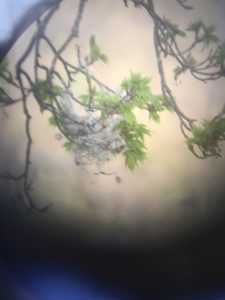
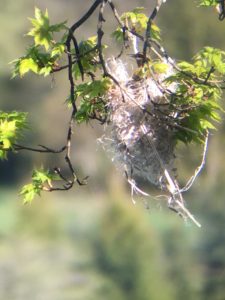
It took her about a week before the weaving was complete, at which point she began bringing soft and fluffy materials to line the inside of her nest. Eventually, I saw the activity of construction come to a halt, and I knew that she was in the egg-laying period.
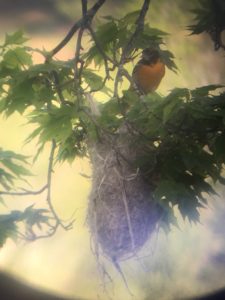
The following week, I began hearing high-pitched, frantic noises coming from the nest. The babies had hatched! I watched both the female and male orioles bring worms and bugs to the nest for their young. Over the following days, it became clear that the babies were getting bigger, as the nest began to droop further downward. Once again, I felt fear surfacing and wondered how much weight Mother Maple’s branch and the oriole’s nest could handle.
One morning after a windy and stormy night, I gazed out my back door to check in on our oriole family. I was shocked to see that the nest had fallen out of Mother Maple’s safe embrace and plunged 20 feet to the ground. I hurried outside and carefully approached the nest, unsure of what to expect. Inside was one small oriole looking scared and calling out in distress. The male oriole chattered angrily overhead, making it clear that I was not welcome in this situation. I relinquished my desire to intervene in some way, and instead returned to my deck and watched the drama unfold from above.
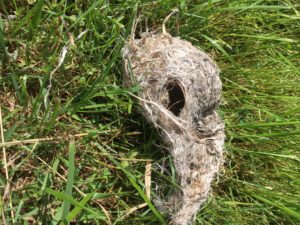
Soon I began hearing multiple calls from young orioles scattered around the yard. The siblings were nearby! I crept back down to Mother Maple and walked around to get a quick glimpse of the young birds. I found three of them perched in nearby grasses and shrubs. They seemed slightly shocked, as if they didn’t know what had just happened. The baby oriole from inside the fallen nest eventually crept out and started following the calls of his or her siblings. Later in the day, the oriole family disappeared. My guess is that the parents rounded up the young and hunkered down in a shrub, waiting a few days until the young were ready to fly.
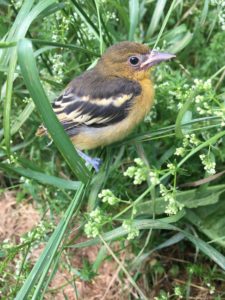
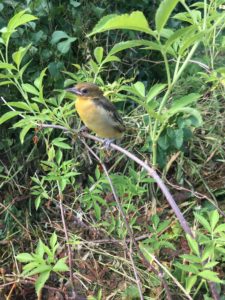
When I initially saw the fallen nest, I wrongfully assumed that the birds didn’t stand a chance for survival. Misfortune can arise and seem so definitive in its outcome, but nature teaches us otherwise. All beings are driven to overcome hardship. We are built to work through adversity and rise up stronger because of it. I imagine these resilient birds are exploring the skies somewhere nearby, vigilant and graceful in their navigation of life’s difficulties.








